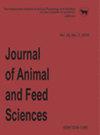Effect of Curcuma longa supplementation in post-weaning lambs ration on performance, carcass and meat quality
IF 1.5
4区 农林科学
Q3 AGRICULTURE, DAIRY & ANIMAL SCIENCE
引用次数: 2
Abstract
. The current study aimed to examine the effects of Curcuma longa (CL) addition to the post-weaning lambs ration on production efficiency and carcass quality. Twenty-eight post-weaning (12–14 week old) Awassi male lambs were randomly divided into four groups of seven lambs each, with the first (T1) group fed a standard ration, and the second (T2), third (T3), and fourth (T4) group fed standard rations supplemented with 100, 200, and 300 mg/kg CL powder, respectively. Treatment lasted 12 weeks. Data analysis revealed that CL supplementation improved ( P ≤ 0.05) overall body weight gain, daily body weight gain, slaughter weight, and hot and cold carcass weight compared to control. In addition, CL-treated (200 and 300 mg/kg doses) animals showed significantly increased empty body weight, dressing %, broad tail fat, and rib eye area in comparison to the control group. Regarding the physical dissection of three ribs, CL significantly enhanced three rib weight and lean % in T3 and T4 compared to other treatments. Bone percentage decreased significantly ( P ≤ 0.05) in T2 and T3, while fat percentage increased significantly in T2 and T3 compared to other treatments. In conclusion, supplementation of post-weaning lamb ration with 300 mg CL improved production traits and meat quality, as well as increased carcass weight, dressing percentage, and lean %. In addition, the fat metabolic pathway in the animal’s body was diverted towards the broad tail, leading to the production of carcasses with a minimal amount of fat desired by consumers.断奶后饲粮中添加姜黄对生产性能、胴体和肉品质的影响
本研究旨在检验在断奶后羔羊日粮中添加姜黄(CL)对生产效率和胴体质量的影响。28只断奶后(12-14周龄)的Awassi公羊羔被随机分为四组,每组7只,第一组(T1)饲喂标准日粮,第二组(T2)、第三组(T3)和第四组(T4)分别饲喂添加100、200和300 mg/kg CL粉的标准日粮。治疗持续了12周。数据分析显示,与对照组相比,补充CL改善了(P≤0.05)总体重增加、日体重增加、屠宰重量以及冷热胴体重量。此外,与对照组相比,CL处理(200和300 mg/kg剂量)的动物显示出显著增加的空体重、敷料%、宽尾脂肪和肋眼面积。关于三根肋骨的物理解剖,与其他治疗相比,CL显著提高了T3和T4的三根肋骨重量和瘦%。与其他治疗相比,T2和T3组的骨百分比显著降低(P≤0.05),而T2和T3的脂肪百分比显著增加。总之,断奶后羔羊日粮中添加300mg CL改善了生产性状和肉质,并提高了胴体重量、屠宰率和瘦肉率。此外,动物体内的脂肪代谢途径被转移到宽阔的尾巴上,导致生产出消费者所需的脂肪含量最低的胴体。
本文章由计算机程序翻译,如有差异,请以英文原文为准。
求助全文
约1分钟内获得全文
求助全文
来源期刊

Journal of Animal and Feed Sciences
农林科学-奶制品与动物科学
CiteScore
2.10
自引率
0.00%
发文量
42
审稿时长
3 months
期刊介绍:
Journal of Animal and Feed Sciences (JAFS, J. Anim. Feed Sci.) has been published by the Kielanowski Institute of Animal Physiology and Nutrition, Polish Academy of Sciences in Jabłonna (Poland) since 1991. It is a continuation of the Polish-language journal Roczniki Nauk Rolniczych. Seria B, Zootechniczna published by the Polish Academy of Sciences since 1969.
JAFS is an international scientific journal published quarterly, about 40 papers per year including original papers, short communications and occasionally reviews. All papers are peer-reviewed and related to basic and applied researches in the field of animal breeding and genetics, physiology of nutrition, animal feeding, feed technology and food preservation. The journal distinguishes the multidisciplinary nature of physiological and nutritional sciences and so includes papers specialized in all fields connected with animal well-being, including molecular and cell biology and the emerging area of genetics.
 求助内容:
求助内容: 应助结果提醒方式:
应助结果提醒方式:


